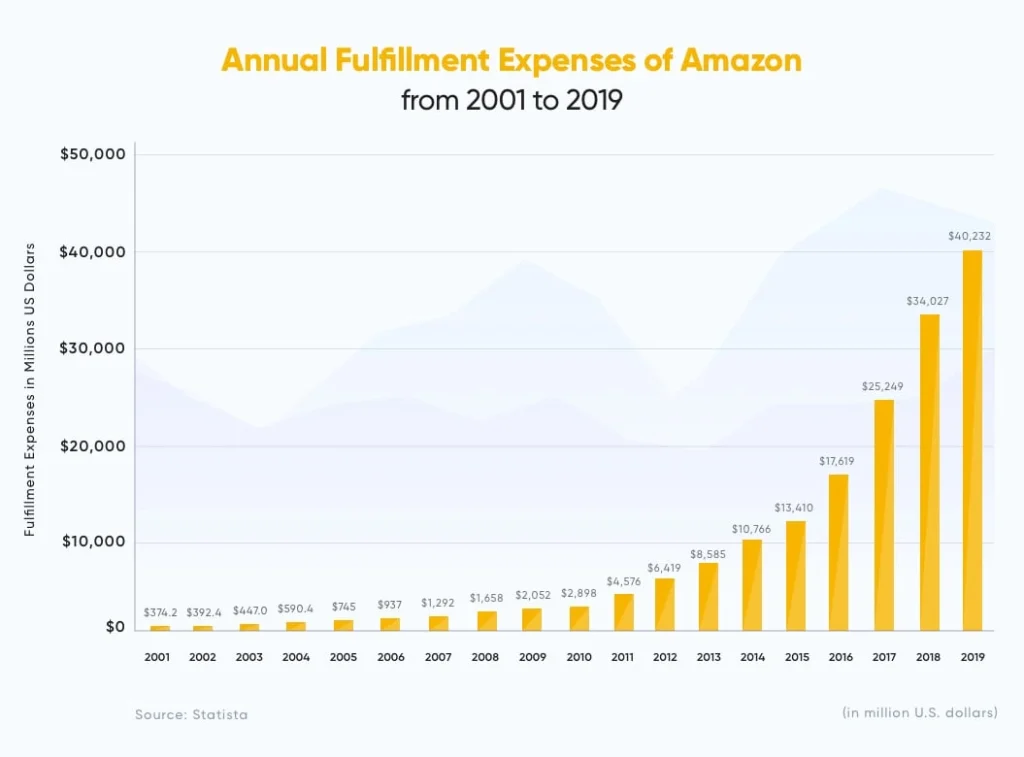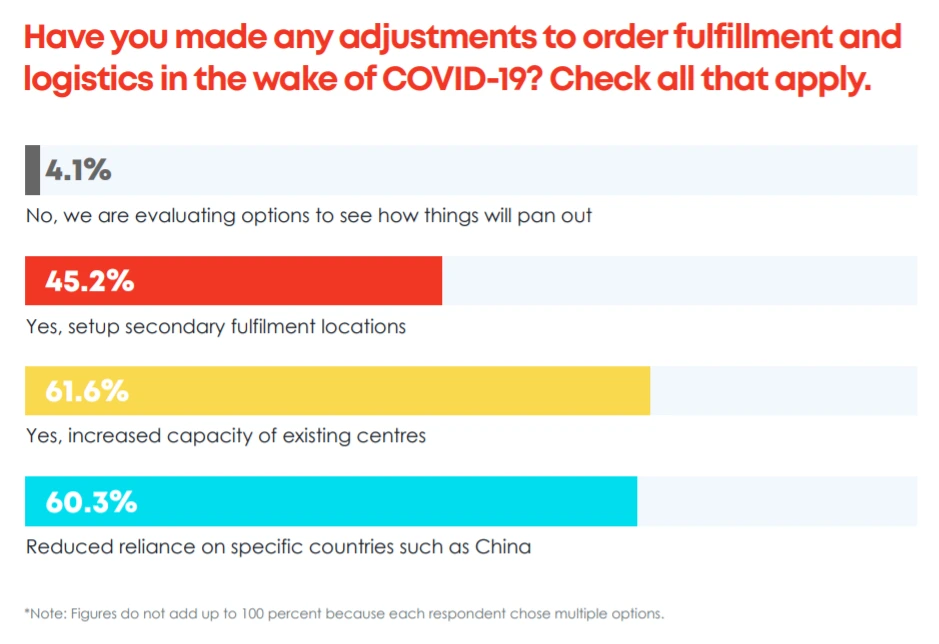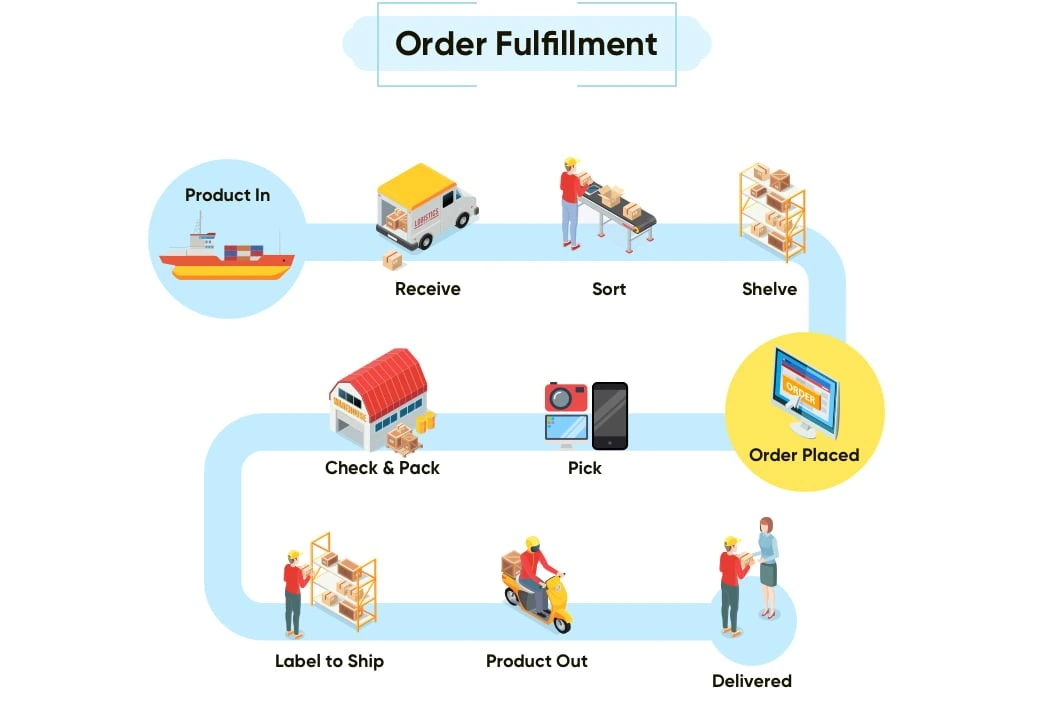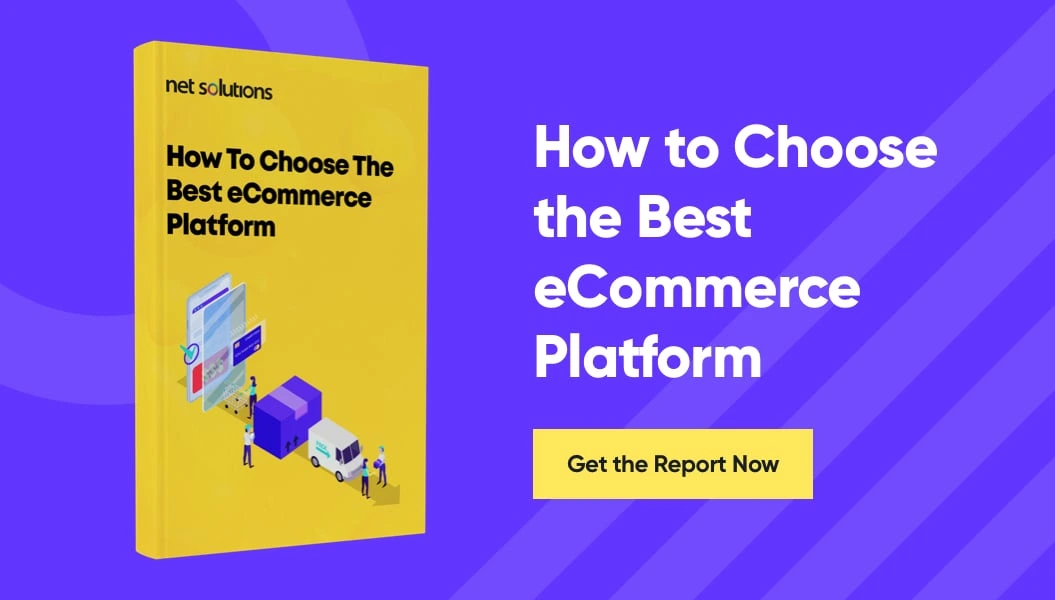Sell to deliver (product + satisfaction) or do not sell at all should be the thumb-rule of every eCommerce business. The technical term that defines eCommerce delivery in the right way is referred to as order fulfillment — the backend process from processing a received order to effective and timely doorstep delivery.
The definition of eCommerce order fulfillment can go beyond doorstep delivery as the “returns and exchange” process is also an active part of eCommerce businesses. Considering that, we can refer to order fulfillment as the process of product delivery in a holistic manner, i.e., receiving the order, packing, transporting, delivery, exchange, and even return.
To trigger a positive shopping experience — businesses need to put efforts to speed up the order fulfillment time, which, in turn, would also lead to an expense hike. Take a look at this fulfillment example of Amazon with respect to their spending over the years.

For a more in-depth insight, here’s everything about order fulfillment.
What is Order Fulfillment?
Order fulfillment is the process of receiving, packaging, shipping, and delivering a product to the customer. The fulfillment also covers exchange and returns processing.
In simple words, fulfillment of any order happens when the interaction between the business and the customer gets closed for the ordered product.
Order fulfillment is often measured based on the time it takes to complete an order completely — which can also be considered one of the essential order fulfillment metrics.
In this era where one-day and two-day delivery eCommerce models are winning, brainstorming around your order fulfillment strategy is imperative.
A digital commerce business can build its dedicated order fulfillment service or rely on a third-party fulfillment provider to complete the order fulfillment steps.
But, how does order fulfillment work? Let us have a look.
What are the Six Steps in the Order Fulfillment Process?
The order fulfillment process includes everything from receiving an order to delivery/returns/exchange.
Here’s an insight into these key steps of the process:
- Receiving Inventory
Receiving inventory refers to the process of gathering the products directly from manufacturers or suppliers at local fulfillment centers.
The primary tasks involved at this stage include:
- Ensuring items count
- A thorough inspection of products for any damage
- Creating Stock-keeping Unit (SKUs — scannable bar codes) for products
- Ensuring product entry to warehouse management software
- Organizing Inventory
Organizing the inventory category-wise on shelves is the second stage that helps ensure fast order fulfillment.
Tip: It is always easier to organize items SKU-wise as it gets easy to pick, pack, and ship them.
It is similar to organizing products in a brick-and-mortar store so that the shopkeeper can quickly locate the item the buyer is asking for. In case the items are scattered all over the shop — more will be the time to find it, and more are the chances of a customer buying from another nearby store.
- Picking
When an order is placed on an eCommerce website/app, it must be tracked across existing inventories for pick and pack. You can easily do this with an inventory management system as a central database repository for all the inventory products.
Digital transformation is also helping in effective and timely picking. For example, eCommerce giants such as Walmart have deployed automated bots called “Alphabots” to facilitate errorless and fast picking and packaging.
Instead of an associate walking the store to fulfill an order from our shelves, automated bots retrieve the items from within the fulfillment center. The items are then brought to a picking workstation, where the order can be assembled with speed.
– Walmart
- Packaging
Packaging involves choosing the right type of packaging box for the ordered product and packing it to ensure safe delivery. If you have your own inventory, you’ll have to upkeep all kinds of packaging materials such as bubble wrap, carton boxes of all sizes, air fills, packaging tapes, and more.
Safe packaging is one of the ingredients that ensure fulfillment as it equates to a better customer experience (it shows that you care).
- Shipping
Once the order is collected from the fulfillment center and is packed securely, you can ship it. You can choose from third-party shipping, merchant shipping, or drop shipping as your mode of shipping orders.
If you go with merchant shipping, you can enable further sub-categorized shipping forms on your eCommerce platform. Your customers can choose what type of shipping they would like to go with based on their pay.
Studies show that stores offering customers a choice of several delivery methods have higher conversion rates than those that use a single method.
– Magento
For instance, the Magento eCommerce platform offers three shipping options to its customers, which include:
- Flat Rate
A flat rate refers to a fixed price that is predefined for product delivery. You can also configure the handling fee here (optional), i.e., the extra charge to ensure safe and secure delivery.
- Free Shipping
Free shipping is a proven way to improve sales on your eCommerce store. You can set a minimum purchase amount for making an order eligible for free shipping.
- Table Rates
A data table is used to calculate shipping rates. The factors on which this rate is calculated include — weight, destination, price, and the number of items.
- In-Store Delivery
The customer can choose a pickup point for the order made, i.e., implementing BOPIS (Buy online, pickup in-store). This is easier for eCommerce stores with brick-and-mortar stores around the area.
On the other hand, when you have a commercial Magento account that supports carriers — the Magento platform allows you to offer your customers a choice over shipping carriers. The choice of shipping carriers such as — UPS, USPS, FedEx, or DPS, in turn, decide the speed of order fulfillment.
- Flat Rate
- Exchange/Return
Returns and exchanges should also be treated as a part of order fulfillment. Whenever the customer makes an exchange/return request, the order processing should begin spontaneously.
An eCommerce business should not consider order fulfillment as order generation to doorstep delivery process. Instead, it should be order generation to a successful return/exchange process.
For instance, you have a Shopify store. The Shopify POS Orders screen can help you manage all the orders in one place. The Orders screen can help review order’s details, add notes to orders, and quickly generate return/exchange requests.
Here’s the complete order fulfillment process flowchart to refer to:
Types of Order Fulfillment
The most popular online order fulfillment methods include — third-party fulfillment, merchant fulfillment, and drop shipping. Here’s what each of them implies:
- Third-Party Fulfillment
Third-party fulfillment refers to the outsourcing order fulfillment process. Third-party fulfillment manages everything from receiving inventory from merchants to order fulfillment.
Third-party Order fulfillment example: Amazon has its self-run fulfillment service called “Fulfillment by Amazon” (FBA) that encourages eCommerce startups to partner with them to enable effective order fulfillment.
Third-party fulfillment should be your go-to option, if:
- It is getting challenging to manage the fulfillment logistics
- It is getting expensive to manage order fulfillment
- You are a small-scale eCommerce business
- Your order fulfillment is slow and is affecting customer experience
- You want to increase customer reach and scale your business quickly
- Merchant Fulfillment
Merchant fulfillment is also known as self-fulfillment or in-house fulfillment and refers to handling order fulfillment on your own without any third-party involvement.
You should choose the merchant fulfillment option if:
- You need to save extra costs in paying third-party online order fulfillment services
- eCommerce business is in its budding stage and has low order volumes to handle
- You are handling order fulfillment from home
- Your eCommerce platform such as Magento, Shopify, BigCommerce, WooCommerce, etc. have in-built inventory management software or supply chain management capabilities to help you with effective order fulfillment
For example:
Magento Inventory Management gives you the tools to manage your product inventory. Merchants with a single store to multiple warehouses, stores, pickup locations, drop shippers, and more can use these features to maintain quantities for sales and handle shipments to complete orders.
– Magento
- Drop Shipping
Drop shipping is an order fulfillment method where the order received is forwarded to the manufacturer, who then handles the shipment and logistics process. This option balances the order fulfillment load between the manufacturer and the eCommerce business.
Drop shipping is a suitable option when:
- You have a minimal budget for investing in fulfillment services
- Your business is new in the market
However, drop shipping is not a recommended order fulfillment option when the speed of delivery is a priority.
Why? Because drop shipping will offer you low control over the supply process and you will not be able to track orders or help your customers follow the order. Moreover, sometimes merchants are located far away from the delivery location, affecting the order fulfillment cycle time.
How to Find Suitable Order Fulfillment Strategy?
Choosing a suitable order fulfillment strategy depends on many factors. Only because a competitor chooses a third-party fulfillment does not mean that choosing merchant fulfillment will do you any harm. All you and your team need to do is evaluate a few parameters before settling on a strategy.
Here are those parameters:
- Order Volume
Sometimes even a small business scales up quickly, and sometimes, it takes years to establish an eCommerce business. The number of order volumes and order fulfillment satisfaction rate decides your business’s fate in the long run.
It is always the right approach to choose an order fulfillment option based on order volume. Here’s a table that can help you narrow down options:
- Order Volume is low: Choose Merchant Order Fulfillment
- Order Volume is large and increasing: Choose Third-party fulfillment
- eCommerce Platform
Your eCommerce platform also helps decide the type of order fulfillment you choose for your business.
If your eCommerce platform supports inventory management and other capabilities that help achieve order fulfillment, sticking to merchant order fulfillment can be considered.
Look at the following examples:
Magento supports Magento Order Management service, which includes benefits such as:
- Track inventory across locations
- A real-time count of stock
- Ability to add locations as the business grows
- Manage order delivery, exchanges, and returns
By developing your platform with Shopify, you can add third-party or merchant fulfillment services to help you track and manage orders from a centralized location.
Shopify also has its own Shopify Fulfillment Network, which is currently active for US and Canada, based eCommerce solutions. The network is suitable for:
- Businesses that support less than 2000 SKUs
- Have order volume between 10-10,000 a day
- Businesses that do not sell “regulated or perishable” items
In case you are planning to choose a third-party fulfillment option, the fulfillment service should allow integration with your chosen eCommerce platform. For example, ShipBob integrates well with Shopify to achieve order fulfillment without a glitch.
You can also compare Magento and Shopify for their inventory management capabilities.
- Geographical Location
Your business location also helps determine the type of order fulfillment service you choose. If you are selling locally, you would be good with merchant fulfillment. On the other hand, if you wish to enable offshore shipments, going with third-party fulfillment will be a suitable option.
No matter what fulfillment you choose, ensure that it is offering the fastest delivery possible.
Nearly a quarter (24%) of shoppers cancel an order because of slow delivery speeds.
The right approach:
- If you are a small business in its budding stage — choose merchant shipping
- When orders start escalating sourcing from multiple locations — choose a third-party fulfillment service that supports multiple fulfillment centers across locations
- If you have limited merchants located in the same or in nearby locations— choose drop shipping
Your chosen eCommerce platform also plays an essential role here to help you manage location-based fulfillment.
Let us suppose an SKU is out-of-stock at one location and available at the other nearby location. In this case, an eCommerce platform such as Shopify will help you divert fulfillment so that it can be acknowledged from a different location.
Shopify’s inventory management feature also lets you fulfill orders based on inventory location. If a customer has ordered multiple items located across inventories, Shopify will help you fetch the inventory location data in one place to help you manage fulfillment.
- Delivery Time
eCommerce setups with one-day and two-day delivery models are making it big in the market — because it enhances customer experience and helps beat the competition.
Thus, every digital retail business focusing on merchant order fulfillment should strategize around shortening the delivery cycle time. Now, there are two sides to this:
- Either you ask your customers to pay for ensuring fast deliveries (which might hamper customer experience)
- You manage the fast delivery fees on your own (which can get expensive)
This is similar to being on the horns of a dilemma.
So, what should be your way forward?
Here are some recommended practices:
- Merge the average shipping cost to the product’s price
- Offer memberships so that customers are paying a one-time fee for enabling free and fast delivery. An example of this could be Amazon Prime that includes a one-time annual fee
- Set a minimum price for enabling free shipping. This way, the customers will add more to the carts, and it will get easier to manage the overall shipping cost for you
Developing with Magento helps with faster deliveries. Here’s how:
- Delivery Date Scheduler — This is an extension for Magento 2 that lets customers choose a desirable delivery window for the product. The affordable delivery dates will be managed at your end
- Same/Next Day Delivery Method — Magento allows you to set the same and next day delivery method based on certain conditions such as — minimum order value, location, extra fees, etc.
On the other hand, Shopify supports apps such as Same-Day Delivery and Mrspeedy same-day delivery to help you maintain a lightning-fast speed of delivery.
Why is Order Fulfillment Important?
Achieving Order fulfillment leads to a delightful customer experience, which, in turn, helps build customer loyalty.
According to Net Solution’s B2B Digital Commerce Report, 30.1% of the companies are planning to quicken order fulfillment time.
Some of the noteworthy benefits of order fulfillment include:
- Ensures timely delivery
- Better inventory management
- Streamlined supply chain pipeline
- Satisfied and happy customers (one of the critical order fulfillment metrics)
- Higher conversion rates leading to increased revenues
- Offers a chance to be fast and collaborative
Order Fulfillment Challenges
Achieving order fulfillment isn’t a cakewalk. You are likely to face many impediments when on the road to offering a delightful customer experience while adding to your revenues.
Moreover, the impact of COVID-19 on businesses has forced many businesses to rewire their order fulfillment strategies as evident according to the Net Solutions’ State of B2B Commerce report.

Here is an insight into some of the common fulfillment challenges faced by digital commerce businesses:
| Challenge | Solution |
|---|---|
| 1. Managing Merchant Order Fulfillment — hiring, expenses, and expertise | Compare the cost of merchant fulfillment vs third-party fulfillment. If the latter seems affordable, third-party can help lower the burden of order management to a great extent |
| 2. Scaling Order Volume | Rely on an eCommerce platform that is flexible and allows you to scale your business with better order management and fulfillment |
| 3. Competition with eCommerce Fulfillment-Driven Giants such as Amazon | Do not focus on competing. Move at your pace, rely on merchant order fulfillment initially, and move on to third-party fulfillment as the business scales up |
| 4. Unsuitability with eCommerce Platform | Choosing the best eCommerce platform should be a priority. Evaluate your business requirements and run a comparison among the available solutions before settling with one |
Conclusion
The better the order fulfillment process, the better is the customer experience, brand impression, customer loyalty, revenues, and overall eCommerce growth.
In this write-up, we explored what is order fulfillment, the underlying process steps, and the corresponding role of eCommerce platforms in driving business growth.
Here’s are some recommendations to help scale your eCommerce business:
- From the three order fulfillment methods, merchant fulfillment, third-party fulfillment, and drop shipping, choose the relevant and affordable option for your business
- You can also consider running a cost analysis test to check for fulfillment strategies that will align well with your business
- Also, before you choose your eCommerce platform, it is essential to understand the support the platform offers towards order processing and fulfillment
In the end, it is all about what technologies you use to run and speed up your eCommerce operations and fulfillment, respectively.
SHARE THIS POST
Table of Contents
Related Resources
- eCommerce App Development Cost: Budgeting In-Depth Guide
- 13 Differences Between B2B and B2C eCommerce Websites
- Top 10 eCommerce Challenges and Easy Ways to Overcome Them
- 3 Types of eCommerce Business Models That Work in 2024
- eCommerce for Business: Is eCommerce Applicable for All Business Types
- eCommerce Customer Journey Mapping - The Secret to Higher Conversion Rates
- What is Headless Commerce? The Ultimate Guide
- Top 15 eCommerce KPIs to Track the Performance of Your Online Business
- Why Your Business Needs a Mobile eCommerce App
- Omnichannel Retail Strategy: A Comprehensive Guide
- Omnichannel vs Multichannel Retailing: The Complete Guide
- PCI Compliance: Everything You Need To Know
- The BEST Guide to eCommerce Personalization
- 12 Essential Factors for Choosing the Best eCommerce Platform
- The Ultimate Guide to Product Information Management (PIM) Systems for Ecommerce
- What is a Product Recommendation Engine (And How it Helps Boost Sales)
- eCommerce Replatforming: Challenges, Benefits, and Best Practices
- The Ultimate Guide to eCommerce Security
- Top 13 eCommerce Trends in 2024
- How Voice Search will Transform the Future of eCommerce
- What is Web Accessibility (And Why it Matters for Your eCommerce Business)





